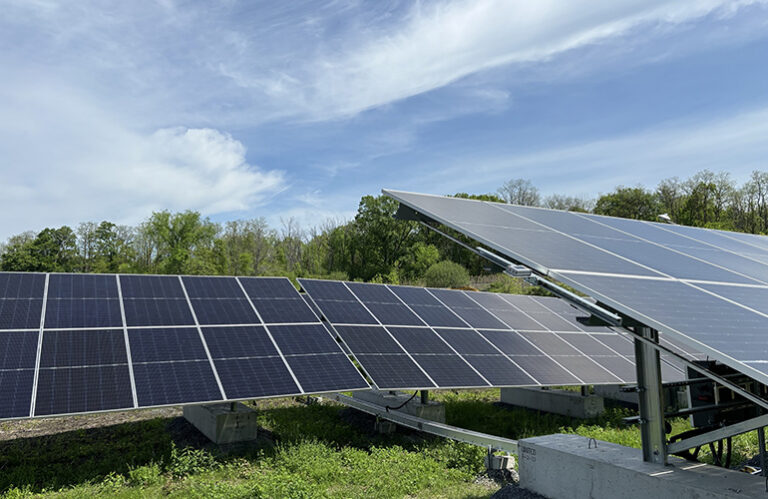Nautilus Solar Energy is no stranger to building solar panels on covered landfills. The New Jersey-based solar developer has completed many solar projects in the Northeast, but building a ballast array at the former Schenectady Army Depot in Albany County, New York, was an entirely new experience.

The community solar project at the former Schenectady Army Depot was built within narrow stretches of capped landfills surrounded by a series of obstacles. Nautilus Solar
The 2.8 MW Altamont solar project is the first community solar project on a previously used defense site (FUDS) in the United States, and Nautilus had to work with the US Army Corps of Engineers to ensure the array met significantly higher standards than ‘normal’. landfill projects.
The Army Corps oversees FUDS to ensure that previous activities, such as the storage of hazardous waste, ammunition or explosives, are remediated and are not actively harming the environment. As a result of this additional government oversight, the permitting and construction timeline for the Altamont array was extended to two years. The management plan for the project alone was hundreds of pages long. Rupal Bain, senior structuring manager at Nautilus, said there were as many as 45 people planning calls for this community solar project.
“We had to thoroughly investigate every potential problem in advance to make sure we had taken it into account, priced it, protected against it and mitigated it so that it ensures smooth construction and operation in the future,” she says. said.
But it was necessary, because designing and building the Altamont project was no easy feat.
A less than optimal project site
The Schenectady Army Depot operated from 1941 to 1969, handling military supplies during World War II and the Korean War. The land was also used for burn pits and landfills.

Given the shape of the allocated project space, many of the rows of solar panels are staggered and contain a varying number of modules. Nautilus Solar
“To be clear, it is not yet entirely clear what is underneath,” says Steve Dzubak, project manager at Nautilus. “That’s it [the army’s] intention not to disrupt the site.”
The area earmarked for solar construction was limited to these capped landfills, which were not exactly vast acres ripe for development. As it was covered over, the land was revegetated, and a private access road built above the slope splits the plot into narrow segments. It is also bordered by its own pond, forest, wetlands, railway lines and an industrial park owned by the current landowner, the Galesi Group.
“The reality is that we had to design the array to fit into very limited spaces because there is no other place to put the array,” Dzubak said. “You cannot enter the wetlands, the railway lines or the highways of the industrial park. It is longer and narrower than you would see on a typical array built into a rectangle.”
The array was designed to fit within the confines of this limited space and within the contours of the land, as grading was not an option. The project was assembled into four separate segments of that narrow land along the access road. Panel rows are staggered and many are a different length than the previous panel rows.
Due to the hedged nature of the land, the Altamont solar panel is mounted in place with concrete ballast blocks. It consists of Adani Solar modules, DCE Solar fixed tilt racks and CPS inverters.
The project cabling was also installed and managed above ground. The installers used heavy machinery with treads instead of tires to transport parts and navigate the site to better distribute weight and reduce the risk of overloading the landfill cap.
“It is a good use of land that is otherwise unusable for the future because of the pollution and the condition of the land and the permanent need to monitor the land,” Dzubak said. “This is a model that can be replicated at other FUD sites.”

The Altamont solar panel was mounted with concrete ballast blocks and follows the contours of the site, as leveling or penetrating the terrain was not an option. Nautilus Solar
FUDS typically have building restrictions, such as excluding residential or public developments there. The Army Corps reported that there are more than 9,300 FUDS in the United States, and while their conditions and volatility may vary, the solar project for the Altamont community is proof that there is an opportunity to return that land to productivity in the long term.
Nautilus owns the Altamont solar project and will operate the array for the next 40 years. Any maintenance work on the project is carried out in-house or via hired O&M partners.
Given the project’s size and relatively delicate construction requirements, Altamont was not the cheapest project to build, Bain said. For her, however, the result was worth it. She previously lived in the nearby city of Schenectady and felt personally motivated to complete this project.
Altamont’s community solar project has transformed an otherwise inaccessible and undevelopable piece of land into something that benefits residents in the area.
“Things can be done if you put the effort and the time in,” Bain said. “Problems are not unsolvable, they just haven’t been solved yet.”


